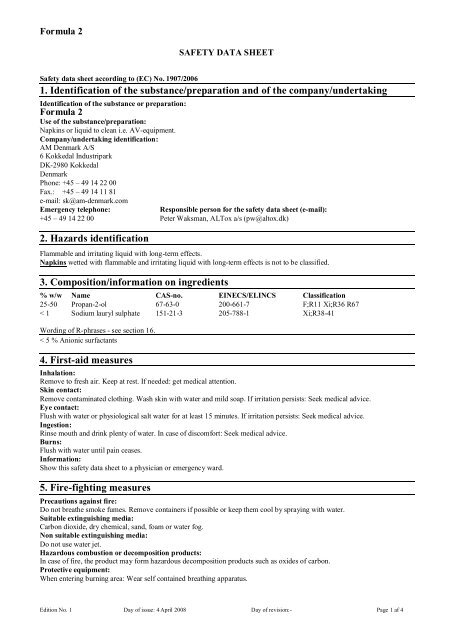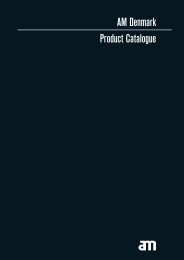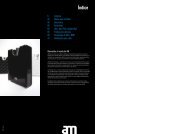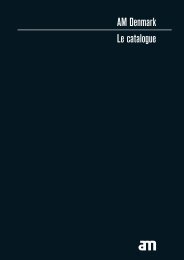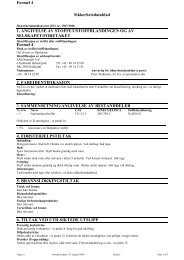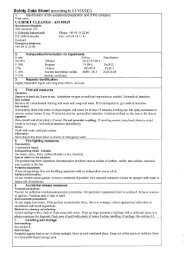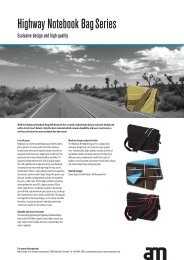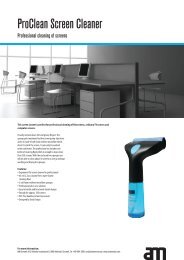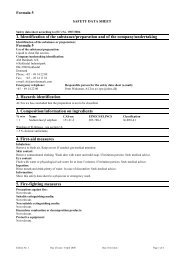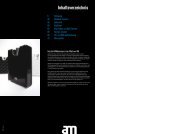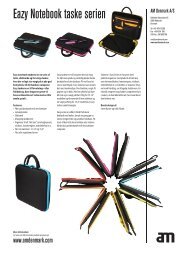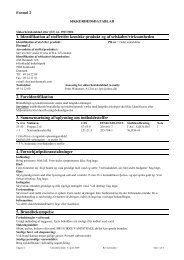Safety Data Sheet - MSDS Rapport (PDF) - AM Denmark A/S
Safety Data Sheet - MSDS Rapport (PDF) - AM Denmark A/S
Safety Data Sheet - MSDS Rapport (PDF) - AM Denmark A/S
You also want an ePaper? Increase the reach of your titles
YUMPU automatically turns print PDFs into web optimized ePapers that Google loves.
Formula 2SAFETY DATA SHEET<strong>Safety</strong> data sheet according to (EC) No. 1907/20061. Identification of the substance/preparation and of the company/undertakingIdentification of the substance or preparation:Formula 2Use of the substance/preparation:Napkins or liquid to clean i.e. AV-equipment.Company/undertaking identification:<strong>AM</strong> <strong>Denmark</strong> A/S6 Kokkedal IndustriparkDK-2980 Kokkedal<strong>Denmark</strong>Phone: +45 – 49 14 22 00Fax.: +45 – 49 14 11 81e-mail: sk@am-denmark.comEmergency telephone:Responsible person for the safety data sheet (e-mail):+45 – 49 14 22 00 Peter Waksman, ALTox a/s (pw@altox.dk)2. Hazards identificationFlammable and irritating liquid with long-term effects.Napkins wetted with flammable and irritating liquid with long-term effects is not to be classified.3. Composition/information on ingredients% w/w Name CAS-no. EINECS/ELINCS Classification25-50 Propan-2-ol 67-63-0 200-661-7 F;R11 Xi;R36 R67< 1 Sodium lauryl sulphate 151-21-3 205-788-1 Xi;R38-41Wording of R-phrases - see section 16.< 5 % Anionic surfactants4. First-aid measuresInhalation:Remove to fresh air. Keep at rest. If needed: get medical attention.Skin contact:Remove contaminated clothing. Wash skin with water and mild soap. If irritation persists: Seek medical advice.Eye contact:Flush with water or physiological salt water for at least 15 minutes. If irritation persists: Seek medical advice.Ingestion:Rinse mouth and drink plenty of water. In case of discomfort: Seek medical advice.Burns:Flush with water until pain ceases.Information:Show this safety data sheet to a physician or emergency ward.5. Fire-fighting measuresPrecautions against fire:Do not breathe smoke fumes. Remove containers if possible or keep them cool by spraying with water.Suitable extinguishing media:Carbon dioxide, dry chemical, sand, foam or water fog.Non suitable extinguishing media:Do not use water jet.Hazardous combustion or decomposition products:In case of fire, the product may form hazardous decomposition products such as oxides of carbon.Protective equipment:When entering burning area: Wear self contained breathing apparatus.Edition No. 1 Day of issue: 4 April 2008 Day of revision:- Page 1 af 4
Formula 26. Accidental release measuresPersonal precautions:Use personal protective equipment - see section 8. Ventilate the area. Remove sources of ignition.Environmental precautions:Avoid large amounts of product entering into drains – see section 12.Methods for cleaning up:Wipe up spillage, etc. with paper towels. Clean with water. Further handling of spillage - see section 13.7. Handling and storageSafe storage:Keep in a well-ventilated area. Store in a well-closed original container and in a flammable liquid storage area. Dry, cool (2-8°C) and separated from oxidizing agents.Specific use(s):See section 1.8. Exposure controls/Personal protectionExposure limits:Substance 8-hour TWA 15-min STELPropan-2-ol 400 ppm = 999 mg/m 3 500 ppm = 1250 mg/m 3Exposure controls:Avoid breathing vapors. Provide sufficient ventilation. Avoid contact with skin, eyes and clothing. Change contaminatedclothes. Wash hands and contaminated areas with water and mild soap after use.The employer shall assess the working conditions and, if there is any risk to the safety or health and any effects on thepregnancy or breastfeeding of workers, take the necessary measures to adjust the working conditions (Directive 92/85/EEC).Flammable, do not use near fire or sparks. Do not smoke.Personal protective equipment:Respiratory protection:Normally not necessary if working in well-ventilated area or by short-term use. In case of working in not adequate ventilatedareas or prolonged use: Wear self contained breathing apparatus because Propan-2-ol vapours are not absorbed by the filter.Skin protection:Use gloves of nitrile rubber or plastic, when there is a risk of prolonged contact with the skin.Breakthrough time: 3 hours.Eye protection:Wear tight fitting safety goggles when risk of splashes.Environmental exposure controls:-9. Physical and chemical propertiesAppearance:Odour:pH: -Boiling point (°C): -Flash point (°C): ~ 26Relative density (g/ml) v/25°C: ~ 1Water solubility:Miscible10. Stability and reactivityClear liquidCharacteristic, pungent.Stability:Stable under the recommended storage conditions (see section 7). Vapours can be ignited by a spark, a hot surface or a glow.Vapours are heavier than air.Conditions to avoid:Formation of sparks and glows. Excessive heating and sources of ignition.Materials to avoid:May react strongly with oxidizing agents.Hazardous decomposition products:When heated to high temperatures (decomposition) it emits toxic fumes such as oxides of carbon.Edition No. 1 Day of issue: 4 April 2008 Day of revision:- Page 2 af 4
Formula 211. Toxicological informationRoutes of exposure:Skin, lungs and gastrointestinal tract.Acute toxicity:Inhalation:Vapours may cause irritation to the airways. Inhalation of larger amounts may induce discomfort, nausea, dizziness,headache, narcosis and unconsciousness.Skin:Degreases skin. Can be absorbed through skin and induce symptoms mentioned for “Inhalation”.Eyes:Causes irritation with redness.Ingestion:May irritate the mucous membranes. May cause symptoms like nausea, vomiting, diarrhoea and symptoms mentioned for“Inhalation”.Long term toxicity:Prolonged or frequent exposure to vapours of volatile organic compounds may result in damage on liver, kidneys, blood orcentral nervous system. Prolonged or frequent contact can cause eczema and inflammation of the skin as a result ofdegreasing.12. Ecological informationEcotoxicity:Sodium lauryl sulphate is toxic to fish. LC 50 (96 hours, fish) = 1-10 mg/l.Propan-2-ol is slightly toxic to fish. LC 50 (fisk, 96h) = 1,4 – 11,1 g/l.Mobility:Soluble in water and good mobility in the aquatic systems is expected.Persistence and degradability:The surfactants in the product pass the ultimate biodegrability test according to EC regulation for surfactants in detergents.Sodium lauryl sulfate is readily biodegradable (>60% BOD, 28d (OECD 301D)).Propan-2-ol is readily biodegradableBioaccumulative potential:No significant bioaccumulation is expected (computer model)Other adverse effects:-13. Disposal considerationsComply with national and local regulations. The preparation is to be considered as hazardous waste.EWC-code:20 01 13Napkins evaporate after use and can be disposed with the household garbage.If packages containing wet napkins must be disposed:EWC-code:20 03 0114. Transport informationUN-no Proper shipping name Class Packing group1987 ALKOHOLS, N.O.S. (Propan-2-ol) 3 III (ADR/RID)Napkins are not dangerous goods (ADR/RID).Edition No. 1 Day of issue: 4 April 2008 Day of revision:- Page 3 af 4
Formula 215. Regulatory informationEC-no.: -Danger symbol:IrritantContent: Propan-2-ol


